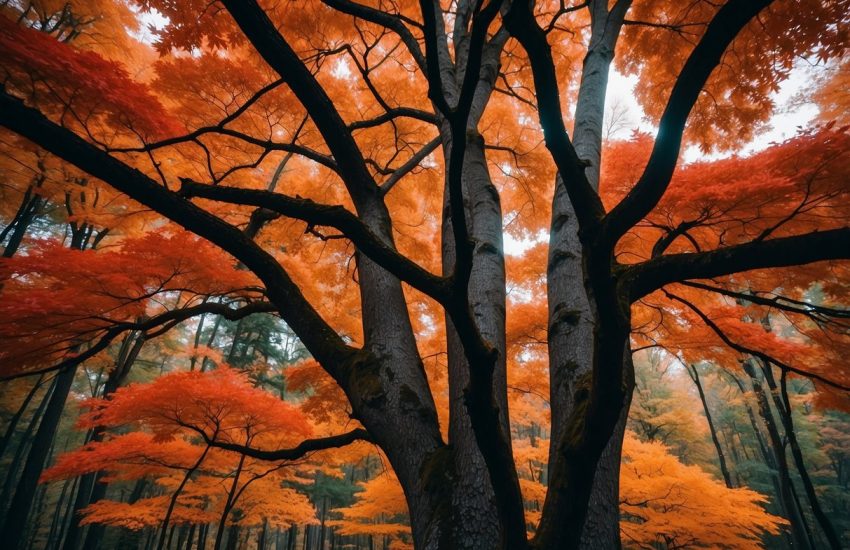Maple Trees in New Jersey: A Guide to Native Species and Where to Find Them
Maple trees are a common sight in New Jersey’s landscape, adding to the natural beauty of the state. These trees are known for their vibrant fall foliage, which turns various shades of yellow, orange, and red, providing a stunning display of colors. They are also strong, large trees that provide ample shade and are an important part of the environment.

New Jersey is home to several species of maple trees, including the red maple, sugar maple, and silver maple. The red maple is the most common type of maple tree in the state and is known for its stunning red fall foliage. Sugar maples are also popular and are known for their sap, which is used to make maple syrup. Silver maples, on the other hand, are known for their fast growth and are often planted as shade trees.
Maple trees are an important part of New Jersey’s environment, providing habitats for various species of birds and insects. They also help to reduce air pollution and provide shade, which helps to reduce energy costs. With their stunning fall foliage and numerous benefits, it is no wonder that maple trees are a beloved part of New Jersey’s landscape.
Diversity and Characteristics of Maple Trees in New Jersey

Maple trees are an integral part of the New Jersey landscape, providing shade, beauty, and environmental benefits. New Jersey is home to several species of maple trees, including the red maple (Acer rubrum), sugar maple (Acer saccharum), and silver maple (Acer saccharinum). Each species has its unique characteristics that make it a valuable addition to any landscape.
Popular Species and Their Traits
The red maple is one of the most common species of maple trees in New Jersey. It is a deciduous tree that can grow up to 80 feet tall and 70 feet wide, providing ample shade for your yard. One of the highlights of the red maple is its vibrant red fall foliage, which adds a splash of color to any landscape. The red maple is also a valuable source of food and habitat for wildlife, including birds and pollinators.
The sugar maple is another popular species of maple tree in New Jersey. It is a slow-growing deciduous tree that can grow up to 100 feet tall and 50 feet wide. The sugar maple is known for its stunning fall foliage, which ranges from yellow to orange to red. The wood of the sugar maple is prized for its strength and durability, making it a popular choice for furniture and flooring. The sap of the sugar maple is also used to make maple syrup, a popular sweetener.
The silver maple is a fast-growing species of maple tree that can grow up to 100 feet tall and 50 feet wide. It is known for its silvery-gray bark and distinctive leaves, which are deeply lobed and have a silvery underside. The silver maple is a valuable source of shade and habitat for wildlife, including birds and pollinators.
Environmental Benefits and Uses
Maple trees provide several environmental benefits, including improving air and water quality, reducing soil erosion, and providing habitat for wildlife. They are also an important source of wood and other products, including maple syrup, furniture, and flooring.
Maple trees are valuable components of the ecosystem, providing habitat and food for a wide range of wildlife, including birds, pollinators, and mammals. They also help to improve air and water quality by absorbing pollutants and reducing runoff.
In addition to their environmental benefits, maple trees are also a valuable source of wood and other products. The wood of maple trees is prized for its strength and durability, making it a popular choice for furniture and flooring. Maple syrup is also a popular sweetener, and is made by tapping the sap of maple trees in the early spring.
Overall, maple trees are an important part of the New Jersey landscape, providing shade, beauty, and environmental benefits. Whether you are looking for a shade tree or a source of maple syrup, there is a species of maple tree that is right for your needs.
Cultivation and Care

Planting and Growing Conditions
Maple trees are a popular choice for gardeners in New Jersey due to their stunning foliage and impressive size. To ensure optimal growth, it is important to choose the right planting location and conditions. Maple trees thrive in well-drained soil that is rich in organic matter, with a pH range of 5.5 to 7.5. They prefer full sun to partial shade and can tolerate a wide range of soil types.
Before planting a maple tree, it is important to prepare the soil properly. Dig a hole that is twice as wide as the root ball and just as deep. Loosen the soil around the edges and bottom of the hole to allow for better root penetration and water drainage. Remove the tree from its container and prune any circling or girdling roots. Score the root ball to stimulate new growth outwardly. Place the tree in the hole and backfill with soil, tamping it down gently to remove air pockets. Water the tree thoroughly and add a layer of mulch around the base to help retain moisture.
Maintenance and Protection
Maple trees require regular maintenance to ensure healthy growth and protect against pests and diseases. It is important to water the tree deeply and regularly, especially during periods of drought. A good rule of thumb is to water the tree once a week, providing 1 inch of water per week. Fertilize the tree with a balanced fertilizer in the spring and fall to promote healthy growth.
Pruning is also an important part of maple tree care. Prune the tree in the late winter or early spring before new growth begins. Remove any dead, diseased, or damaged branches, as well as any branches that are crossing or rubbing against each other. This will help improve air circulation and prevent the spread of diseases.
Maple trees are susceptible to a number of pests and diseases, including aphids, scale insects, and verticillium wilt. Regular inspections and treatments can help prevent these problems. If you notice any signs of pests or diseases, contact a professional tree care service for advice and treatment options.
In summary, growing maple trees in New Jersey requires attention to soil, water, sunlight, and maintenance. With proper care, maple trees can thrive and provide years of beauty to the garden state.


